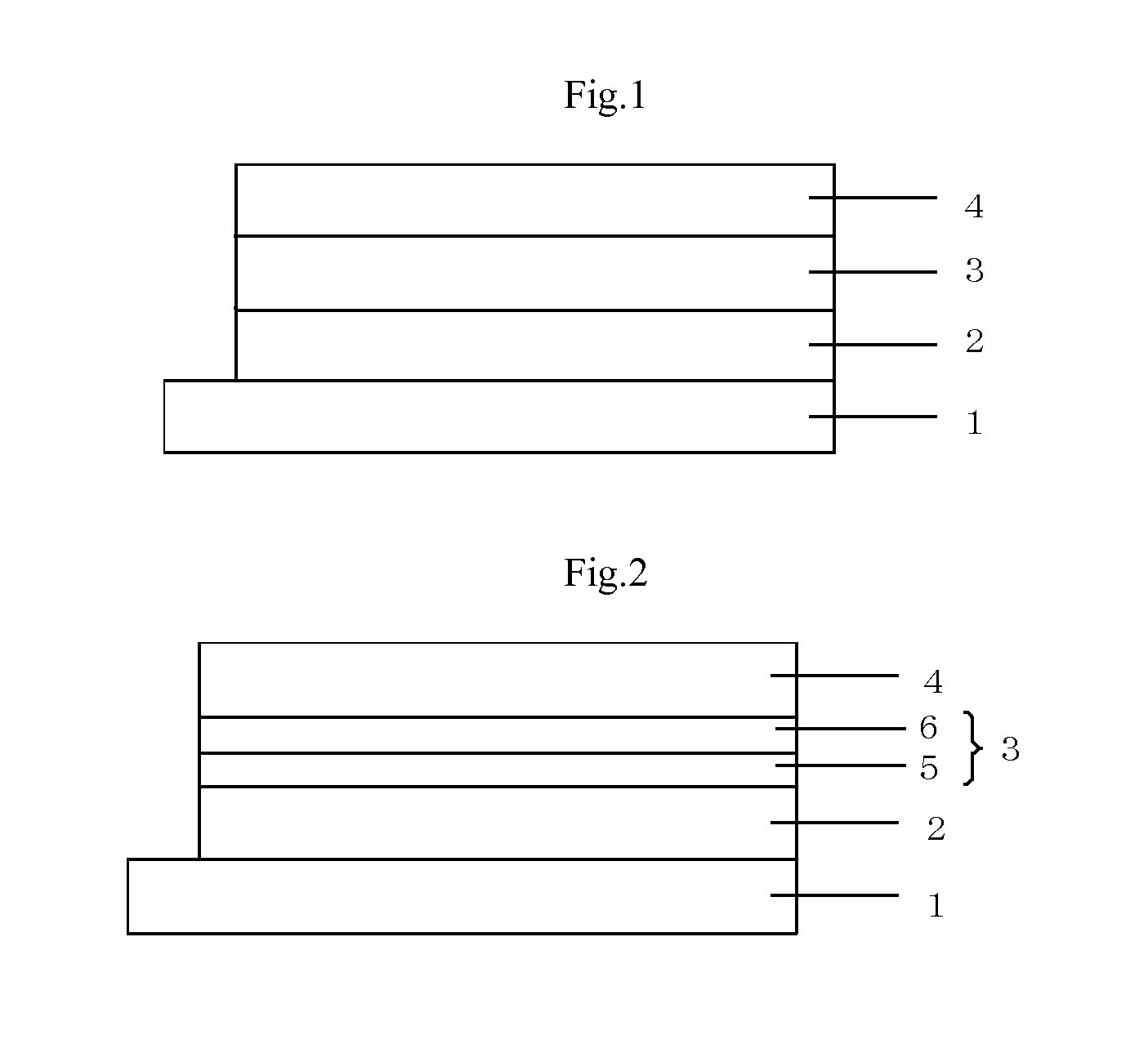Electron donating material, material for photovoltaic devices and photovoltaic device
a technology of organic materials and electron donors, applied in the direction of solid-state devices, organic chemistry, chemistry apparatus and processes, etc., can solve the problems of low photoelectric conversion efficiency of solar cells, high cost mainly derived from the process of producing semiconductor films, and inability to spread widely to homes, etc., to achieve high short-circuit current density (isc), high photoelectric conversion efficiency, and high open-circuit voltage
- Summary
- Abstract
- Description
- Claims
- Application Information
AI Technical Summary
Benefits of technology
Problems solved by technology
Method used
Image
Examples
synthesis example 1
[0082]Compound A-1 was synthesized by the method illustrated in Scheme 1.
[0083]To 150 ml of 48% hydrobromic acid (produced by Wako Pure Chemical Industries, Ltd.) were added 4.3 g of compound (1-a) (produced by Tokyo Chemical Industry Co., Ltd.) and 10 g of bromine (produced by Wako Pure Chemical Industries, Ltd.), and the resulting mixture was stirred at 120° C. for 3 hours. After cooling the mixture to room temperature, precipitated solid was separated by filtration by a glass filter, and then washed with 1000 ml of water and 100 ml of acetone. The resulting solid was dried in vacuum at 60° C. to obtain 6.72 g of compound (1-b).
[0084]In 100 ml of dimethylformamide (produced by Kishida Chemical Co., Ltd.) was dissolved 10.2 g of compound (1-c) (produced by Tokyo Chemical Industry Co., Ltd.), and then 9.24 g of N-bromosuccinimide (produced by Wako Pure Chemical Industries, Ltd.) was added, and the resulting mixture was stirred under a nitrogen atmosphere at room temperature for 3 ho...
synthesis example 2
[0091]Compound A-2 was synthesized by the method illustrated in Scheme 2.
[0092]In 15 ml of chloroform (produced by NACALAI TESQUE, Inc.) was dissolved 0.734 g of the compound A-1 (produced by Tokyo Chemical Industry Co., Ltd.), and then 0.23 g of N-bromosuccinimide (produced by Tokyo Chemical Industry Co., Ltd.) / 10 ml of dimethylformamide (produced by Wako Pure Chemical Industries, Ltd.) were added, and the resulting mixture was stirred under a nitrogen atmosphere at room temperature for 9 hours. To the resulting solution were added 100 ml of water and 100 ml of chloroform. Then, an organic layer was fractionated, washed with 200 ml of water, and then dried with magnesium sulfate. The resulting solution was purified by column chromatography (filler: silica gel, eluent: dichloromethane / hexane) to obtain 0.58 g of compound (2-a).
[0093]To 7 ml of 1,4-dioxane (produced by Wako Pure Chemical Industries, Ltd.) were added 0.5 g of compound (2-b) (produced by Tokyo Chemical Industry Co., Lt...
synthesis example 3
[0095]Compound A-3 was synthesized by the method illustrated in Scheme 3.
[0096]To 7 ml of 1,4-dioxane (produced by Wako Pure Chemical Industries, Ltd.) were added 0.34 g of compound (3-a) (produced by Tokyo Chemical Industry Co., Ltd.), 0.85 g of bis(pinacolato)diboron (produced by BASF Japan Ltd.) and 0.86 g of potassium acetate (produced by Wako Pure Chemical Industries, Ltd.). Under a nitrogen atmosphere, 0.21 g of [bis(diphenylphosphino)ferrocene]dichloropalladium (produced by Aldrich Chemical Company, Inc.) was added and the resulting mixture was stirred at 80° C. for 9 hours. To the resulting solution were added 100 ml of water and 100 ml of ethyl acetate. Then, an organic layer was fractionated, washed with 100 ml of water, and then dried with magnesium sulfate. The resulting solution was purified by column chromatography (filler: silica gel, eluent: dichloromethane) to obtain 167 mg of compound (3-b).
[0097]In 6 ml of toluene were dissolved 110 mg of the compound (2-a) and 17...
PUM
| Property | Measurement | Unit |
|---|---|---|
| Energy | aaaaa | aaaaa |
| Energy | aaaaa | aaaaa |
| Nanoscale particle size | aaaaa | aaaaa |
Abstract
Description
Claims
Application Information
 Login to View More
Login to View More - R&D
- Intellectual Property
- Life Sciences
- Materials
- Tech Scout
- Unparalleled Data Quality
- Higher Quality Content
- 60% Fewer Hallucinations
Browse by: Latest US Patents, China's latest patents, Technical Efficacy Thesaurus, Application Domain, Technology Topic, Popular Technical Reports.
© 2025 PatSnap. All rights reserved.Legal|Privacy policy|Modern Slavery Act Transparency Statement|Sitemap|About US| Contact US: help@patsnap.com



